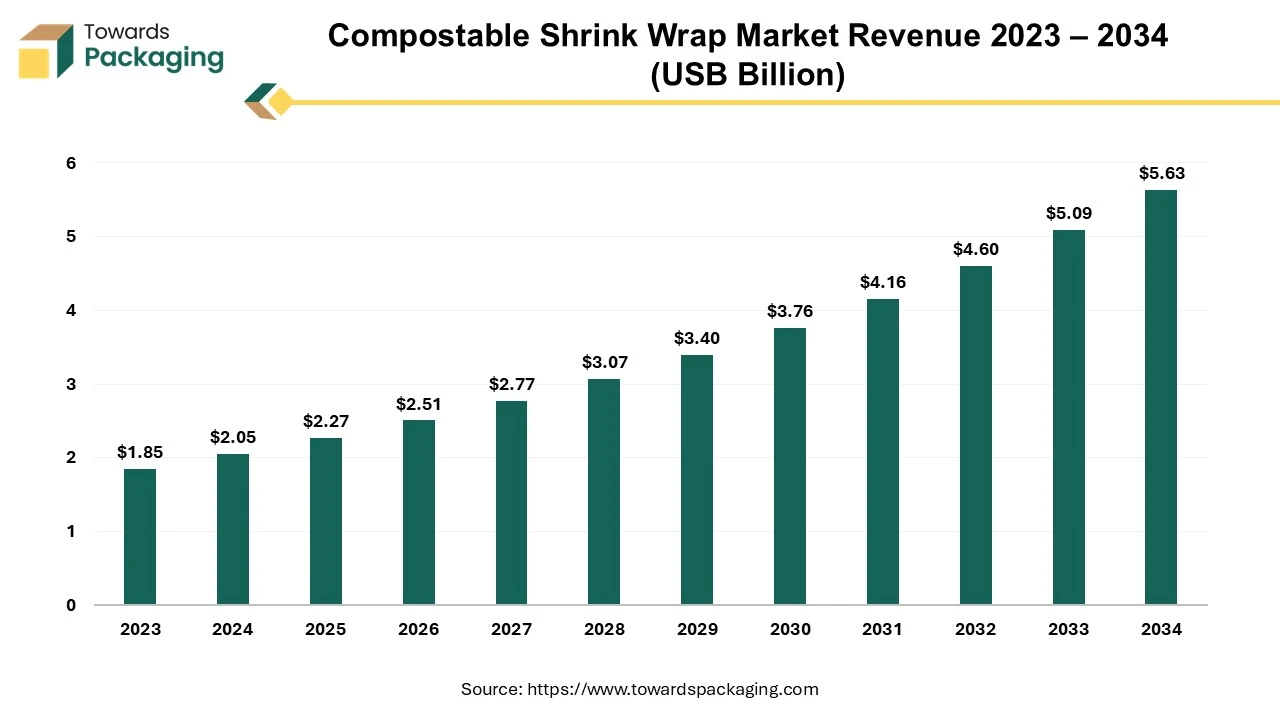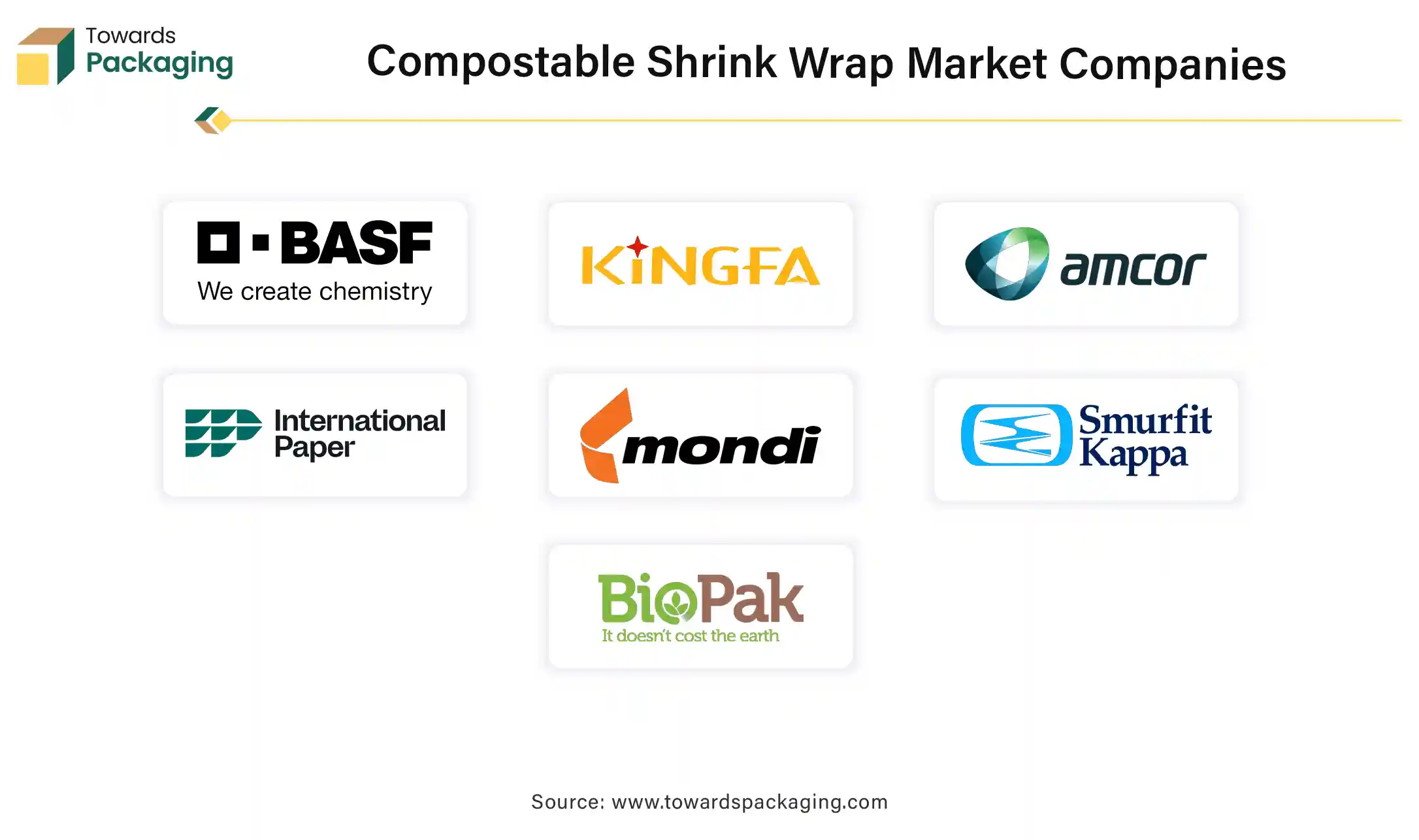February 2025
The global compostable shrink wrap market size reached US$ 2.05 billion in 2024 and is expected to attain around US$ 5.63 billion by 2034, growing at a CAGR of 10.65% from 2025 to 2034.

The global compostable shrink wrap market is growing as compostable shrink films are innovative and environmentally friendly alternatives to traditional plastic shrink wrap. They are ideal for many applications such as packaging multiple finished product packages, presenting fresh products and bakery products, or as a secondary wrap for packaged goods.
The global compostable shrink wrap market is growing rapidly due to its superior features such as excellent sealing, strong shrinkage, durability, transparency, and machinability. The compostable shrink wrap is also available in printed form. Compostable shrink wraps are certified for food contact and would be a good solution as contaminated food can be composted. Market looking for an alternative to plastic shrink wrap can reduce their plastic use with compostable shrink wrap options. It provides the same functionality as traditional shrink wrap, while also being environmentally friendly.
It is designed to naturally decompose over time, reducing its impact on the environment. Compostable shrink-wrap materials are made from plant-based materials such as PLA (polylactic acid) or PBAT (polybutylene adipate terephthalate). The materials are derived from recycled materials and are compostable. Some compostable shrink wraps are also compostable. They can be added to the composting process to break down organic matter and enrich the soil. The strength of compostable shrink wrap helps reduce the thickness of the film compared to traditional PE film.
For Instance,
Demand for compostable shrink wrap is increasing in industries such as food and beverage, cosmetics, and pharmaceuticals as companies search for effective solutions. The innovative shrink wrap is ideal for packaging single products, bundling products, and securing pallet loads; particularly in new product packaging, it provides a breathable and protective layer that extends shelf life while reducing the impact on the surrounding environment. In addition, the use of compostable shrink wrap in food waste packaging caters to busy lifestyles and solves the ecological problems associated with waste packaging.
The emergence of edible biodegradable films made from materials such as seaweed or fruit pulp represents a groundbreaking change that allows consumers to enjoy packaging that can be eaten along with their products. These two benefits not only eliminate waste but also improve the overall customer experience, making biodegradable shrink wrap a major driver for the growth of the global compostable shrink wrap market.
EcoShrink brings a significant opportunity to the global compostable shrink wrap market by addressing the beginning and end of the product lifecycle. Made from industry-proven compostable resin and containing 45% biopolymer, EcoShrink is not only sustainable but also designed for fire-resistant electric heating models, allowing users to package small and large items.
Its shelf life and stability mean that it retains its integrity until properly disposed of in a commercial composting environment, reducing the amount of plastic waste that would normally end up in landfill. As the industry increasingly focuses on sustainability, EcoShrink is positioning itself as an effective solution based on environmental strategies, thus creating a robust market opportunity for growth in compostable packaging solutions.
For Instance,
The global compostable shrink wrap market faces significant constraints due to the higher cost of compostable packaging materials and complex manufacturing processes compared to conventional products. These cost issues hinder scalability and impede the ability to achieve cost competitiveness in the market. Furthermore, the lack of guidance and certification for compostable products creates confusion and conflict among consumers and businesses alike, undermining trust in these products. Addressing these issues through the development of clear standards and effective control procedures is critical to overcoming these limitations and spurring the growth of the packaging sector.
Asia Pacific dominated the compostable shrink wrap market in 2024, the region is observed to sustain during the forecast period due to the growth of compostable bioplastic products, presenting Asia-Pacific Economic Cooperation (APEC) economies with an opportunity to harness the potential of a growing circular economy to address the increasingly harmful societal impacts associated with plastic pollution. Many companies in the Asia Pacific are focusing on short-term, reusable, and easy-to-pack packaging, increasing the use of recycled materials and eventually switching to product-based packaging.
Many stakeholders in the Asia-Pacific region are also developing innovative alternatives to traditional plastic disposal. For instance, WRAP Asia Pacific is the regional arm of WRAP, a UK-based climate action NGO, and works with the Ellen MacArthur Foundation to bring together governments and organizations to tackle plastic packaging, textiles, food, and drink, leading the growth of global compostable shrink wrap market.
By regional insight, North America is expected to grow at the rapid pace in the compostable shrink wrap market during the forecast period, with at least 11% of the U.S. having access to composting programs that accept some compostable materials in addition to their packaging waste. In the United States, 15% of compostable materials are packaged in some form. In addition to reducing plastic waste, the business model also allows US packaging companies to produce packaging locally, thereby reducing greenhouse gas emissions from transportation.
While the consumers trust sees compostable and plant-based products to provide the most sustainable packaging (72% and 70% respectively), many other types of packaging are also being cut back, according to multiple accountable surveys, consumers rank as extremely or very sustainable. U.S. packaging companies are allowed to produce packaging locally, thus reducing greenhouse gas emissions associated with transportation. Compostable films and laminates can be processed at the same line speed as flexible materials, driving the growth of the global compostable shrink-wrap market.
For Instance,
By Type
By type, the PLA (polylactic acid) segment dominates the global compostable shrink wrap market as PLA (polylactic acid) shrink film is a compostable bioplastic derived from renewable materials rather than petrochemicals. It has a very high shrink ratio and requires less heat to shrink while delivering performances similar to the other films during processing. PLA shrink film manufacturer specializing in providing clear/transparent PLA film and matte PLA film for flexible packaging and shrink labels.
Whereas PHA (Polyhydroxyalkanoates) segment is the fastest growing in the global compostable shrink wrap market as PHA can be modified to have a variety of properties, from rigid and hard to flexible and elastic. This makes them suitable for a variety of applications, including packaging, agricultural films, and accessories. They are also FDA-approved for food packaging.
By Application
In terms of application, the food packaging segment dominated the global compostable shrink wrap market as a commercially compostable alternative to plastic shrink wrap, which is widely used in industrial packaging applications. It is ideal for domestic use or food service and can work on packaging fresh produce.
Whereas industrial packaging segment is the fastest growing in the global compostable shrink wrap market as compostable shrink film or wrap is a packaging product manufactured from certified compostable paper and biodegradable corn starch raw materials, as they are produced from renewable resources and are alternatives to petrochemical feedstocks that require intensive use of fossil fuels and traditional hydrocarbons resins. The packaging industry relies on shrink-wrapping as it renders numerous advantages like flexibility, strength, recyclability, and illustration capability.

By Type
By Application
By Geography
February 2025
February 2025
January 2025
February 2025